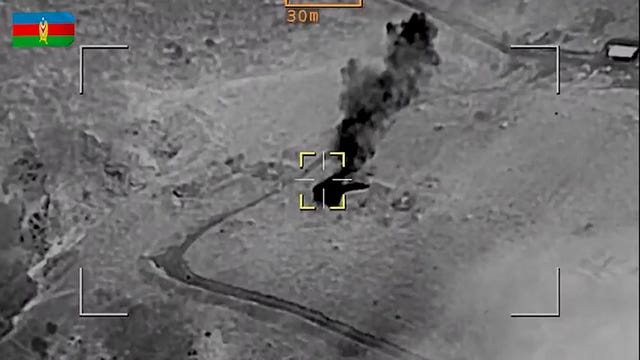Azerbaijan and Armenian forces have reached a ceasefire agreement to end two days of fighting in the separatist Nagorno-Karabakh region that has been a flashpoint for decades, officials on both sides said.
An hour after the truce was announced, Armenian Prime Minister Nikol Pashinyan said the intensity of the hostilities in the region “has decreased drastically”.
Azerbaijani authorities said they had halted the military operation launched a day earlier once separatist officials announced the laying down of arms. But it was not immediately clear if some fighting continued.
On Tuesday, Azerbaijan unleashed heavy artillery fire on Armenian positions in Nagorno-Karabakh — a mountainous region that is part of Azerbaijan and came under the control of ethnic Armenian forces during a separatist war in the 1990s.

Scores of people were reportedly killed and wounded in the latest fighting. The hostilities also exacerbated an already grim humanitarian situation for residents who have suffered food shortages for months.
The escalation raised concerns that a full-scale war in the region could resume between Azerbaijan and Armenia, which have been locked in a struggle over the region since the collapse of the Soviet Union.
The most recent heavy fighting occurred over six weeks in 2020, when Azerbaijan retook parts of the region and areas around it that were lost in the earlier separatist war.
The conflict has long drawn in powerful regional players, including Russia and Turkey.
While Turkey threw its weight behind Azerbaijan, Russia has taken on a mediating role and brokered the armistice that ended the 2020 fighting.
Its contingent of peacekeepers, in fact, are charged with monitoring that truce, and both sides said on Wednesday that they helped reach the current agreement.
Russia’s Defence Ministry said some of its peacekeepers were killed on Wednesday, although it did not say how many and whether it happened before or after the start of the ceasefire.
Earlier on Wednesday, Kremlin spokesman Dmitry Peskov said that, in effect, Azerbaijan was acting on its own territory.
“I hope that we can achieve de-escalation and solve this problem via peaceful channels,” Russian President Vladimir Putin said later.
Talks between Azerbaijani officials and the region’s ethnic Armenian authorities on its “reintegration” into Azerbaijan were scheduled to take place on Thursday.
The deal envisions the withdrawal of Armenian military units and equipment from Nagorno-Karabakh, as well as disarming the local defence forces, Azerbaijan’s Defence Ministry said.

Mr Pashinyan said his government did not take part in discussing or negotiating the deal, but “has taken note” of the decision made by the region’s separatist authorities.
Azerbaijan said it fired on Armenian positions on Tuesday as part of what it called an “anti-terrorist operation” and vowed to continue until “illegal Armenian military formations” surrendered.
Azerbaijan has alleged that Armenia has smuggled weapons into the territory since the end of the separatist war. The claims led to a blockade of the road connecting Nagorno-Karabakh to Armenia, causing food and medicine shortages.
Azerbaijan has accused Armenian forces of attacking its positions in the region, planting landmines and engaging in acts of sabotage.
Armenia’s Foreign Ministry denied that its weapons or troops were in Nagorno-Karabakh, and its prime minister alleged that Azerbaijan’s main goal is to draw it into hostilities.
Azerbaijan’s forces claimed to be only targeting military sites but ethnic Armenian officials in Nagorno-Karabakh said that Stepanakert, the capital of the breakaway region, and other villages were “under intense shelling” on Tuesday.
Before the ceasefire, blasts reverberated around Stepanakert every few minutes on Wednesday morning, with some explosions in the distance and others closer to the city.
Significant damage was visible on the streets of the city, with shop windows blown out and vehicles punctured, apparently by shrapnel.

Local residents on Tuesday moved to basements and bomb shelters, and the fighting cut off electricity. Food shortages persisted in the area, with limited humanitarian aid delivered on Monday not distributed due to the shelling.
Nagorno-Karabakh human rights ombudsman Geghan Stepanyan said on Wednesday that 32 people, including seven civilians, were killed and more than 200 others were wounded. Mr Stepanyan earlier said one child was among those killed, and 11 children were among the wounded.
The Azerbaijani Prosecutor General’s Office said Armenian forces fired at Shusha, a city in Nagorno-Karabakh under Azerbaijan’s control, killing one civilian.
The claims could not be independently verified.
Russia’s Defence Ministry said on Wednesday that its peacekeeping contingent had evacuated more than 2,000 civilians, but did not give details on where they were taken.
On Tuesday, thousands of protesters rallied in central Yerevan, the capital of Armenia, blocking streets and demanding that authorities defend Armenians in Nagorno-Karabakh. Some clashed with police, who reportedly used stun grenades.
Russia’s state news agencies reported that protesters began to gather again in the centre of Yerevan on Wednesday, shortly after the ceasefire agreement was announced.




Comments: Our rules
We want our comments to be a lively and valuable part of our community - a place where readers can debate and engage with the most important local issues. The ability to comment on our stories is a privilege, not a right, however, and that privilege may be withdrawn if it is abused or misused.
Please report any comments that break our rules.
Read the rules here